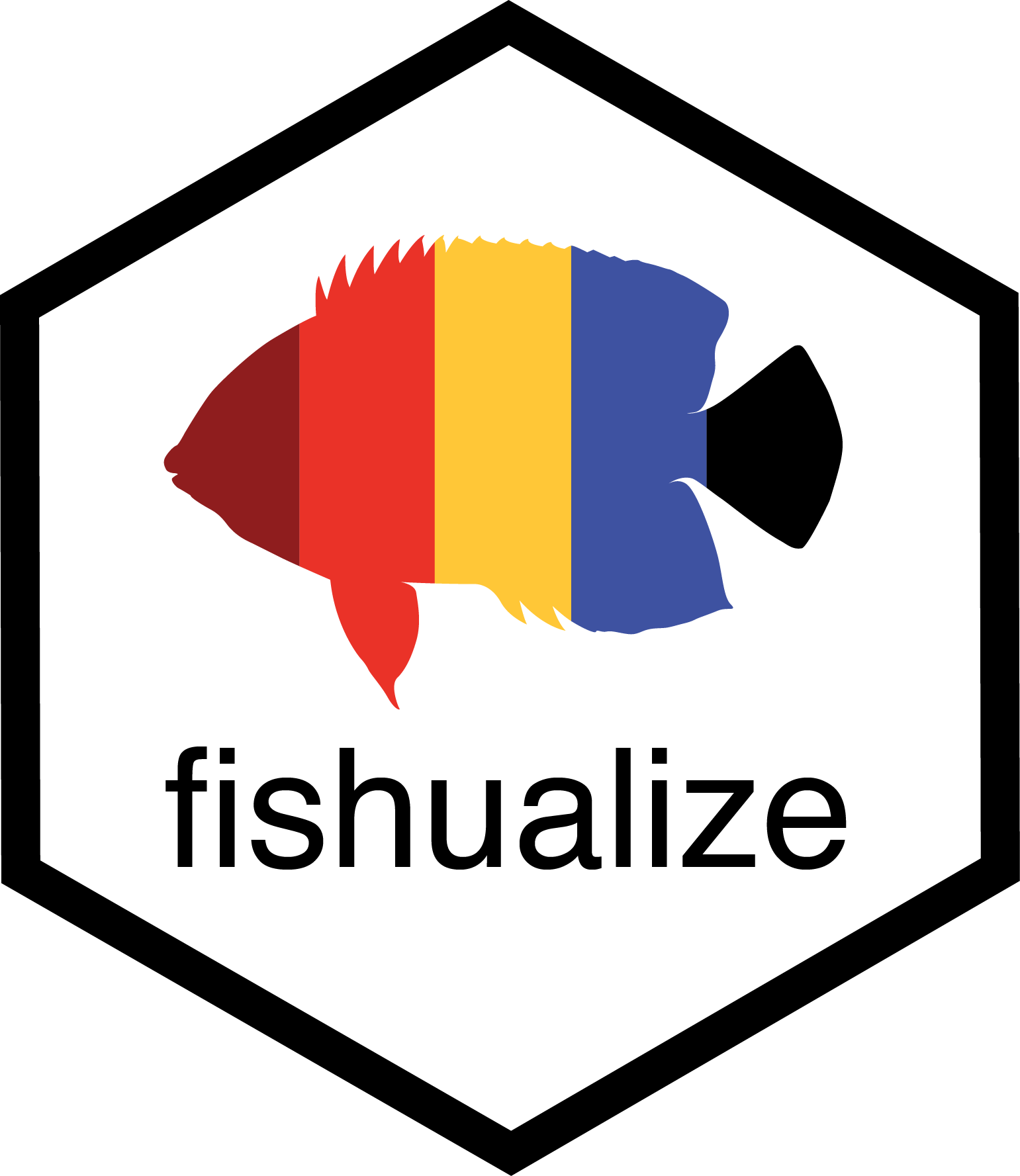The fishualize package provides color scales for plotting in R based on nature’s most stunning and colorful organisms: teleost fishes (with a few chondrichthyan cameos). #TeamFish in its colorful glory.
install.packages("fishualize")
library(fishualize)or for the latest development version:
library(devtools)
devtools::install_github("nschiett/fishualize", force = TRUE)
library(fishualize)The package contains one scale per species, defined by five dominant
colors. The number of fishualized species will expand over time. For a
list of fish species that are currently available, run
fish_palettes().
A visual overview of the color scales can be found
here.
To visualize a fish color palette, you can run fishualize() and
specify your choice.
fishualize()fishualize(n = 8, option = "Hypsypops_rubicundus", end = 0.9)The fish() function produces the fish color scale based on your
favorite species, which can be specified using ‘option’ =
“Your_favorite” or fish_palettes()[] with the number of your species
specified.
For base R plots, use the fish() function to generate a palette:
pal <- fish(256, option = "Trimma_lantana")
image(volcano, col = pal)pal <- fish(10, option = "Ostracion_cubicus")
image(volcano, col = pal)The package also contains color scale functions for ggplot2 plots:
scale_color_fish() and scale_fill_fish().
library(ggplot2)
library(rfishbase)
# load data for plotting
# 1. Create list of species names currently featured in fishualize
spp <- fishualize::fish_palettes()
# 2. Get data on the included species from FishBase using the rfishbase package
dt <- rfishbase::species(gsub("_"," ", spp))
dt$Importance = factor(dt$Importance, levels = c("highly commercial", "commercial", "minor commercial", "subsistence fisheries", "of no interest"))
# plot bars with discrete colors using color scheme provided by Scarus quoyi
ggplot(dt[!is.na(dt$Importance),]) +
geom_bar(aes(x = Importance, fill = Importance)) +
scale_fill_fish_d(option = "Scarus_quoyi") +
theme_bw() +
theme(axis.text.x= element_blank() )# plot points with continuous colors provided by Hypsypops rubicundus
ggplot(dt) +
geom_point(aes(x = Length, y = Vulnerability, color = Vulnerability), size = 3) +
scale_color_fish(option = "Hypsypops_rubicundus", direction = -1) +
theme_bw()## Warning: Removed 1 rows containing missing values (geom_point).
# get ecological information from FishBase
data <- rfishbase::ecology(gsub("_"," ", spp), c("SpecCode","FeedingType", "DietTroph")) %>%
dplyr::left_join( rfishbase::species(gsub("_"," ", spp)))
# plot boxplots of length across feeding groups using discrete colors provided by Cirrilabrus solorensis
ggplot(data[!is.na(data$FeedingType),]) +
geom_boxplot(aes(x = FeedingType, y = log(Length), fill = FeedingType )) +
scale_fill_fish_d(option = "Cirrhilabrus_solorensis", labels = c("invertivore", "herbivore", "carnivore", "planktivore", "omnivore")) +
theme_bw() +
theme(axis.text.x= element_blank() )# examine relationships between size and trophic level with vulnerability as a continuous color scheme provided by Lepomis megalotis
ggplot(data) +
geom_point(aes(x = Length, y = DietTroph, color = Vulnerability), size = 6, alpha = 0.9) +
scale_color_fish(option = "Lepomis_megalotis", direction = -1) +
theme_bw()## Warning: Removed 48 rows containing missing values (geom_point).
Colors can also be used with maps. Here are several examples of discrete and continuous color schemes on a world-map.
library(ggplot2)
#get dataset of the world's countries
world <- rnaturalearth::ne_countries(scale = "medium", returnclass = "sf")
#plot worldmap with each country's estimated population as a continuous colors scale based on the reverse colors of Whitley's Boxfish Ostracion whitleyi
ggplot(data = world) +
geom_sf(aes(fill = pop_est)) +
scale_fill_fish(option = "Ostracion_whitleyi", direction = -1) +
theme_bw() +
theme(legend.position = "top")#plot worldmap with each country's estimated gdp based on the colors of the Sailfin Tang Zebrasoma velifer
ggplot(data = world) +
geom_sf(aes(fill = gdp_md_est)) +
scale_fill_fish(option = "Zebrasoma_velifer", trans = "sqrt") +
theme_bw()+
theme(legend.position = "top")#same example as above but starting at a lighter point of the color scale
ggplot(data = world) +
geom_sf(aes(fill = gdp_md_est)) +
scale_fill_fish(option = "Zebrasoma_velifer", trans = "sqrt", begin = 0.3, end = 1) +
theme_bw()+
theme(legend.position = "top")#plot worldmap again, this time with countries colored by their respective regional affiliation using the colors of the Clown coris *Coris gaimard* and 'discrete = TRUE'
ggplot(data = world) +
geom_sf(aes(fill = region_wb)) +
scale_fill_fish(option = "Coris_gaimard", discrete = TRUE) +
theme_bw()+
theme(legend.position = "top")##same map with colors reversed
ggplot(data = world) +
geom_sf(aes(fill = region_wb)) +
scale_fill_fish(option = "Coris_gaimard", discrete = TRUE, direction = -1) +
theme_bw()+
theme(legend.position = "top")#another map with countries colored by economic status using the colors of the Mandarinfish *Synchiropus splendidus*
ggplot(data = world) +
geom_sf(aes(fill = income_grp)) +
scale_fill_fish(option = "Synchiropus_splendidus", discrete = T, alpha = 0.8) +
theme_bw()+
theme(legend.position = "top")#same map as above but with a narrower color palette in discrete values
ggplot(data = world) +
geom_sf(aes(fill = income_grp)) +
scale_fill_fish(option = "Synchiropus_splendidus", discrete = T, alpha = 0.8, begin = 0.3, end = 1) +
theme_bw()+
theme(legend.position = "top")Love it? Missing your favorite species? Check out how you can contribute to this package here
Thanks to everyone contributing to the color palettes: Jindra Lacko, Andrew Steinkruger, Adam Smith.
Credits for the initial structure of the functions for this package go
to the harrypotter package made by Alejandro Jiménez:
https://github.com/aljrico/harrypotter

















